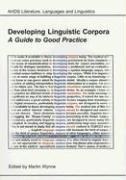Read more
A linguistic corpus is a collection of texts that have been selected and brought together so that language can be studied on the computer. Today, corpus linguistics offers some of the most powerful new procedures for the analysis of language, and the impact of this dynamic and expanding sub-discipline is making itself felt in many areas of language sub-discipline is making itself felt in many areas of language study. In this volume, a selection of leading experts in various key areas of corpus construction offer advice in a readable and largely non-technical style to help the reader to ensure that their corpus is well designed and fit for the intended purpose. This guide is aimed at those who are at some stage of building a linguistic corpus. Little or no knowledge of corpus linguistics or computational procedures is assumed, although it is hoped that more advanced users will find the guidelines here useful. It is also aimed at those who are not building a corpus, but who need to know something about the issues involved in the design of corpora in order to choose between available resources and to help draw conclusions from their studies. The Arts and Humanities Data Service (AHDS) has produced this series of Guides to Good Practice to provide the arts and humanities research and teaching communities with practical instruction in applying recognized standards and good practice to the creation, preservation and use of digital resources. All Guides identify and explore key issues and provide comprehensive pointers for those who need more specific information. As such they are essential reference materials.

